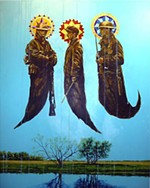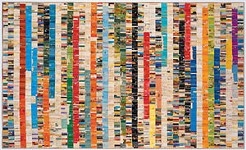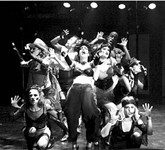‘"New American Talent: The Eighteenth Exhibition"’
Local Arts Reviews
Reviewed by Molly Beth Brenner, Fri., Aug. 8, 2003

'New American Talent: The Eighteenth Exhibition': Eye of the Beholder
Arthouse at the Jones Center for Contemporary Art, through Aug. 24
Although emotional and intellectual responses to art vary wildly, one rarely hears people publicly disagree about a recognized artist's basic talent quotient. I may not prefer the work of Cy Twombly, for example, but I'm not about to say that he lacks talent. I'd squirm in the role of Arbiter of Talent even if asked to play it; I don't have the requisite confidence or knowledge to sit in that seat.
Good thing I'm not Dominic Molon, associate curator of the Museum of Contemporary Art in Chicago and curator of "New American Talent: The Eighteenth Exhibition" for Arthouse. To construct a complete exhibit of contemporary talent is, of course, impossible: Not even the considerable expanses of Mass MoCA could hold all the phenomenal work emerging from this country's gifted creators. And Molon, who sifted through the work of more than 670 artists to assemble this exhibition, doesn't pretend to have gathered the 34 artists with the "most talent" out of all those that submitted. Instead, he sees himself as a sort of subjective filter, writing in the show's catalog that the collection is "a reflection not only of the kind of talent that now exists in the emergent American art scene, but also a gauge of what this particular contemporary art curator wants, needs, or prefers to see when looking at art."
I found Molon's comment to be especially pertinent, for although there is significant variety in the styles, media, and geographical origins of the work showing at Arthouse, and even though the amount of raw talent displayed is staggering, Molon's taste is also clearly represented. In his choices he leans toward the sardonic, the humorous, and the hip, with lots of brightly surreal color and texture. Photography is central to this show, whether modified by painted-on, cartoonlike figures (Stuart Hyatt's Ghost Rider series); centered on arranged scenes (Kerstin Lee Jones' Red Hallway); or awash with extreme lighting (Geoffrey E. Aronson's prosaic yet luminous photos). So is photorealistic painting, along with other highly representational art. Hemlock, a lush, lifelike portrait of the poisonous plant by team painters Robert Davis and Michael Langlois, demonstrates both the irony and realistic technique that seem to be exhibition themes. Timothy Tompkins' 9-28-02 (After Rembrandt) follows this vein; made with enamel on aluminum, it resembles an Impressionistic landscape in pastel plastic until you gain distance enough to see that it's actually a scene of police brutality, blurred like a news photo.
The show also includes some abstract and new-media pieces. These, too, conform snugly to Molon's droll, bright aesthetic. Niki Kriese's funhouse geometric bands and Michelle Wasson's Fantasia-like landscapes suggest the wild fashion textiles of the Seventies and Eighties, and Siebren Versteeg's digital program, a silent news program with onscreen closed-captioning scrolling inane trivialities and banal self-talk, is a ludicrous cap to this modern journey. Yet despite the innovative quality of the show's art, the most striking element of Arthouse's exhibition is the visible trace of its curator's preferences. The personal tastes of the subjective "filters" we employ to identify new talent strongly influence what kind of art we see and truly mold the definition of "talent" for the future.










